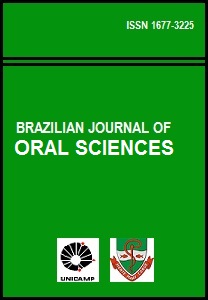Abstract
Candidosis is a common fungal infection in the oral cavity of humans. Candida albicans is the specie most frequently isolated from this infection. C. albicans ability to adhere to host tissue is considered an important step in the development of candidosis. In order to verify the role of saliva on the implantation and permanency of C. albicans in the oral cavity, 52 mice, 26 with normal salivary flow and 26 xerostomic, received a single inoculum with 0.1 mg of the sediment of C. albicans (ATCC 36801) suspension containing 108 viable cells/mL. The permanency of C. albicans in the oral cavity of mice was verified 1, 2, 3, 5, 8 days after inoculation and then, in 15 days intervals until negativity of the test. Saliva sample was collected with a sterile “cotton ball” kept in the oral cavity of the animals for 5 minutes. The data obtained showed that xerostomic mice harbored C. albicans in the oral cavity until 75 days while the normal group was positive until 30 days after inoculation. The number of xerostomic and normal mice positive to C. albicans was the same until 48 h, and greater in the xerostomic group until the end of experiment. No statistically significant differences were observed between the cfu/mL of C. albicans recovered from the oral cavity of xerostomic and control mice. These data showed that although xerostomia did not have any influence on the number of candidal particles in the oral cavity, it favored the permanence of the yeast in the mouth of the animals for a longer period.The Brazilian Journal of Oral Sciences uses the Creative Commons license (CC), thus preserving the integrity of the articles in an open access environment.
Downloads
Download data is not yet available.

